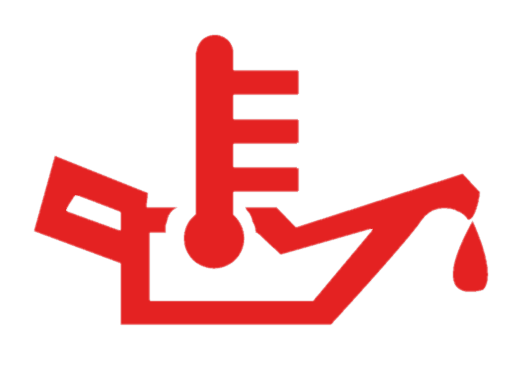Oil Temperature Warning Light
Not all vehicles have the oil temperature warning light. The red oil temperature warning light illuminates due to the temperature of the oil being excessively hot. If driving, it’s advised that you pull off the road as soon as it’s safely possible and switch off the engine to allow the engine to cool down.
Continued driving may result in your engine oil temperature reaching a critical level causing thermal breakdown of the oil. This will affect the oil viscosity, causing rapid degradation, which in turn reduces the lubrication properties of the engine’s internal components. How susceptible the oil is to thermal breakdown depends on its quality (how refined it is) and age.
Why is the Oil Temperature Warning Light On?

You’ll need to investigate the causes of why the oil temperature warning light has come on. Due to the risk of burns and scolding, always allow the engine sufficient time to cool before making any maintenance checks.
Engine Coolant
A lack of engine coolant is going to increase engine temperature and cause the oil temperature warning light to come on. Check the engine coolant reservoir tank and ensure that the level is above the minimum marker.
Degraded Engine Coolant
Check in your coolant reservoir at the quality of coolant. Antifreeze is an essential component to a vehicle’s engine. It not only prevents freezing, but also raises the boiling temperature of the fluid. The colour of antifreeze varies, but the fluid should not be cloudy or murky. Check also that the consistency is water-like and not thick or sludge-like. If it is, you’ll need to flush the coolant system and replace it with new antifreeze. Degraded antifreeze might not be as free-slowing within the cooling system and will lose temperature and corrosion protection.
Air in the Cooling System
Another reason for an overheating engine is trapped air in the cooling system. Trapped air pockets prevent heat from being carried away from the engine. In this instance, you’ll need to bleed the cooling system.
Water Pump
The water pump circulates coolant around the engine keeping it cool. As water pumps age, seals may rupture and bearings become worn resulting in an ineffective cooling system. Symptoms of a failing water pump include overheating engine, coolant leaks. Failing bearings may make a whining or grinding noise. If the water pump id driven by a belt, check that the drive belt or serpentine belt is in place and not worn, too lose or damaged.
Radiator Fan
When your car is moving at speed, air flows through the radiator which keeps the coolant cool. When the vehicle is moving at a slow speed or stationary, the radiator fan produces this airflow. The radiator / cooling fan is temperature activated and does not run continuously. The next time you engine is running hot, check to ensure the radiator fan is operating.
Low Oil Level
Engine oil not only lubricates the internal components, but helps to remove heat – particularity engine that operate oil coolers. Very low oil levels will begin to impact component lubrication resulting in increased friction that in turn produces more heat. Check the engine oil level using the dipstick.
Degraded Engine Oil
Engine oil as it ages loses its lubrication properties and amasses debris and engine deposits. This reduces the lubrication efficiency and increases heat. It’s recommended that engine oil is changed between 3000 to 5000 miles.
| Other Dashboard Warning Lights |
|---|
